Abstract
To determine whether asthma alone can cause irreversible airflow obstruction 42 men and 47 women with chronic asthma (mean duration 22 (SD 13) years) without evidence of other disease likely to cause irreversible airflow obstruction were treated with theophylline orally and a beta agonist both orally and by inhalation for four weeks. After two weeks of treatment the FEV1 was less than 85% of the predicted normal value (%P) in 48 patients and these individuals then received prednisolone 0.6 mg/kg/day for two weeks. Duration and severity of asthma and smoking history were quantified by questionnaire; 38 patients were current smokers or ex-smokers. FEV1 was measured at 0, 2, and 4 weeks. The mean difference between the best FEV1 during the study and the predicted normal value was 0.29 l (p less than 0.001); FEV1 %P decreased with age (r = -0.30, p less than 0.01) and with the duration (r = -0.47, p less than 0.001) and severity (r = -0.55, p less than 0.001) of asthma. Similar findings were noted when the results for non-smokers and those whose asthma started in adult life were analysed separately. We conclude that asthma alone can cause irreversible airflow obstruction and that the degree of obstruction is a function of the duration and severity of previous asthma. The results suggest the possibility that irreversible airflow obstruction in asthma may be preventable by minimising the degree of persistent asthma.
Full text
PDF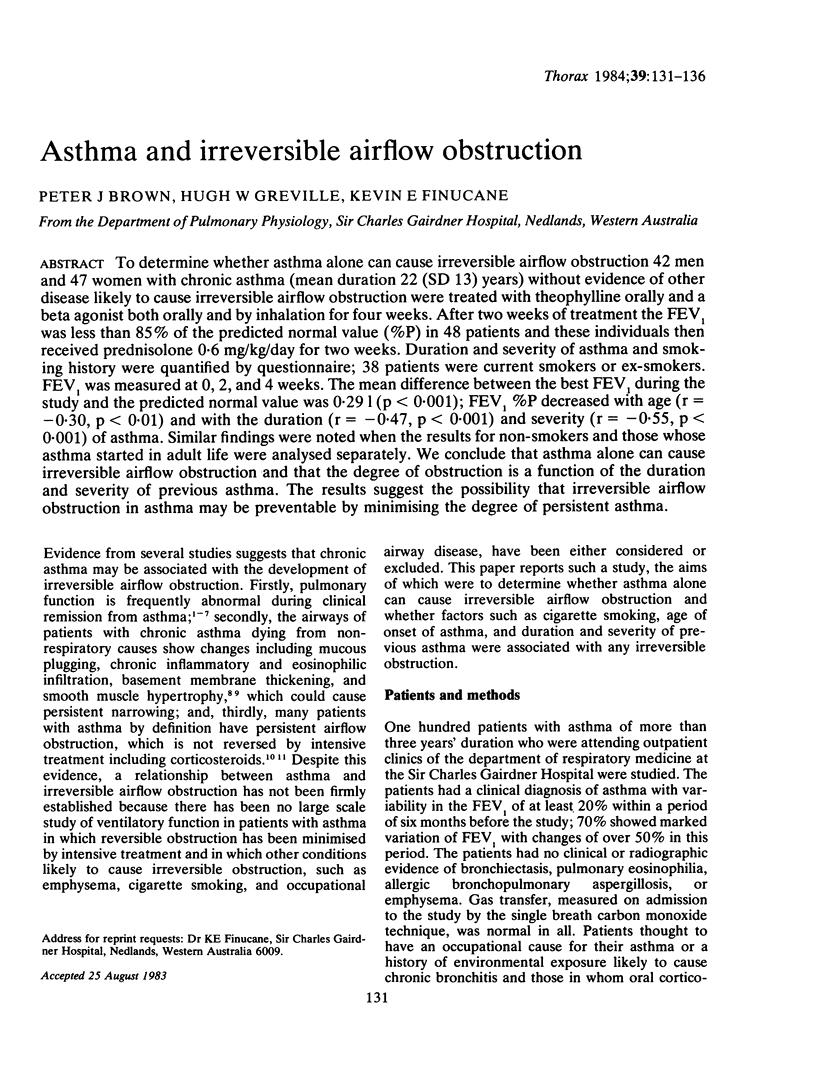
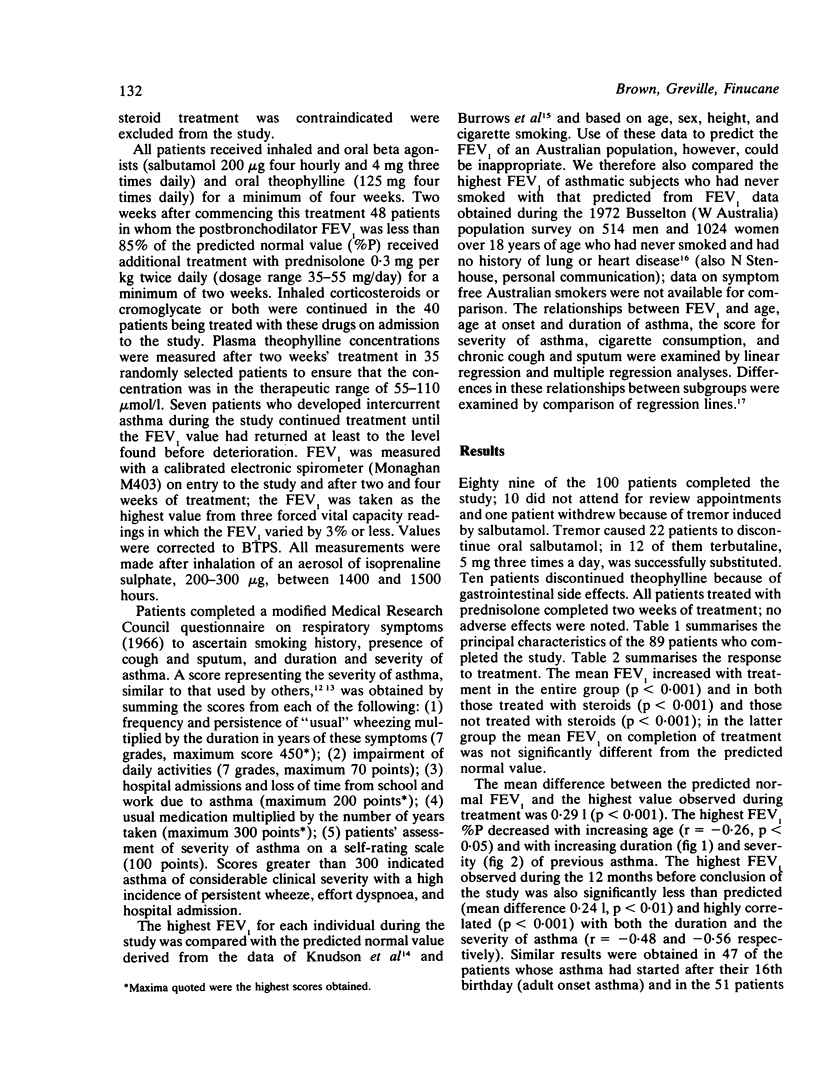
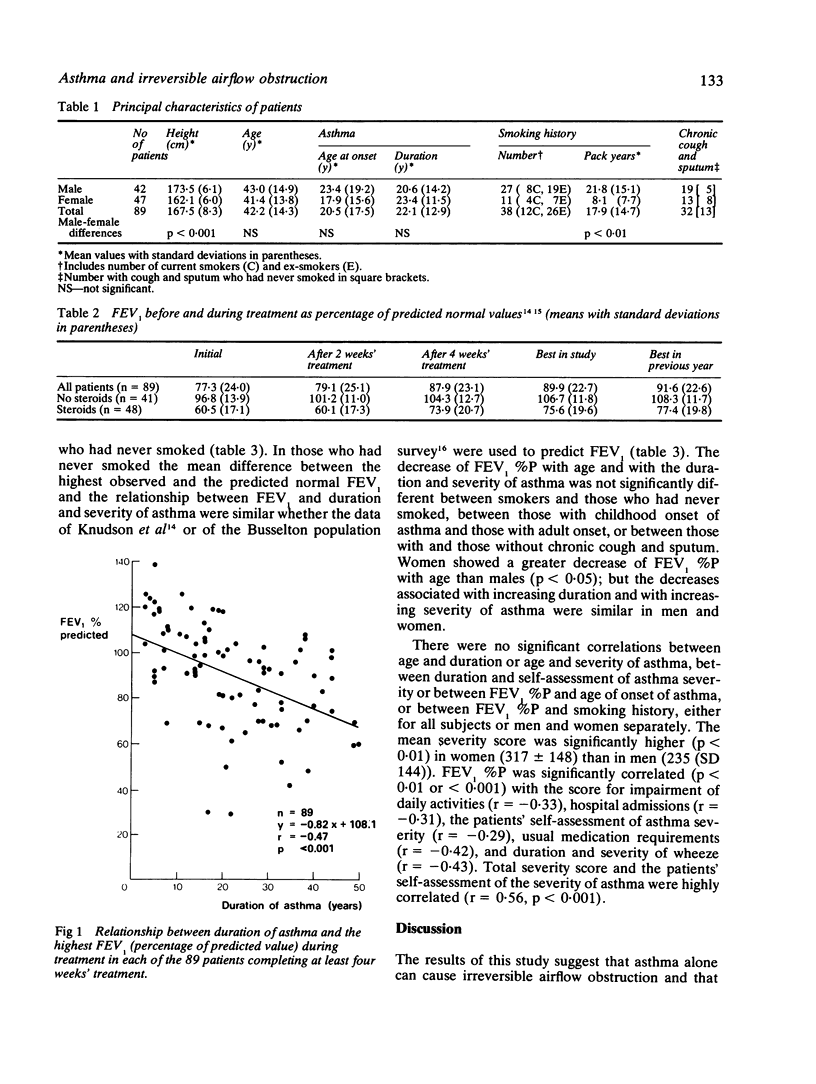
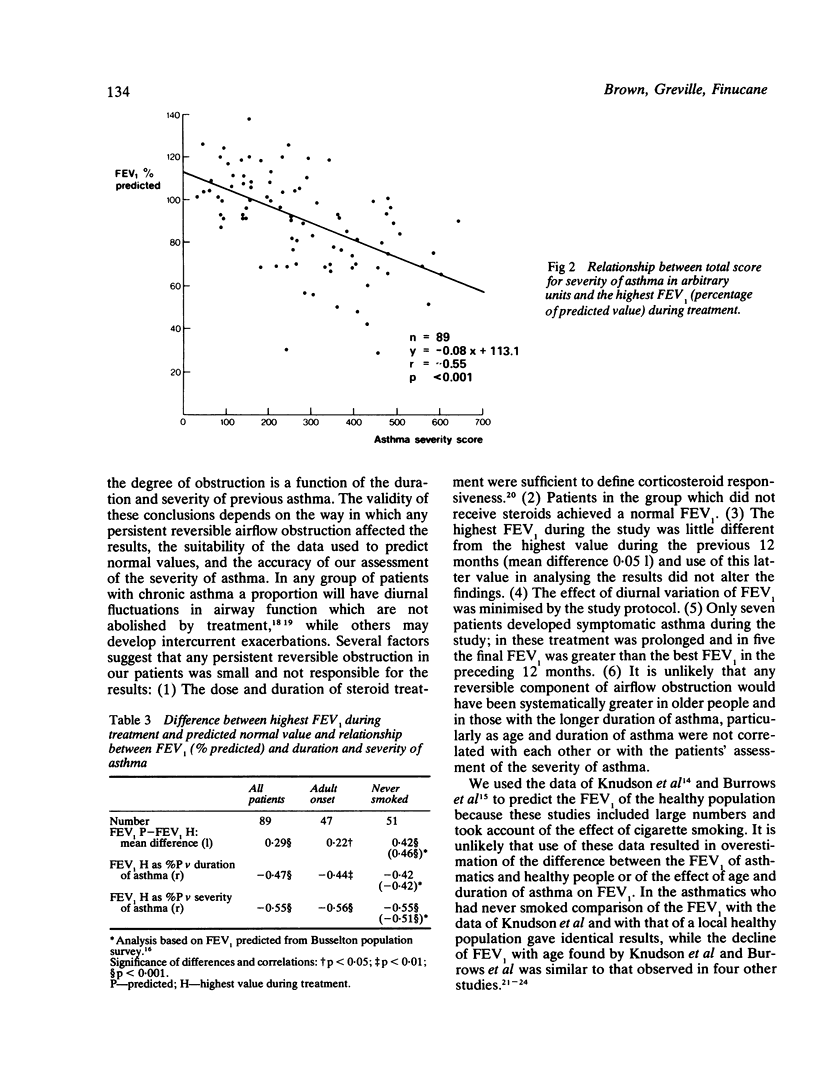
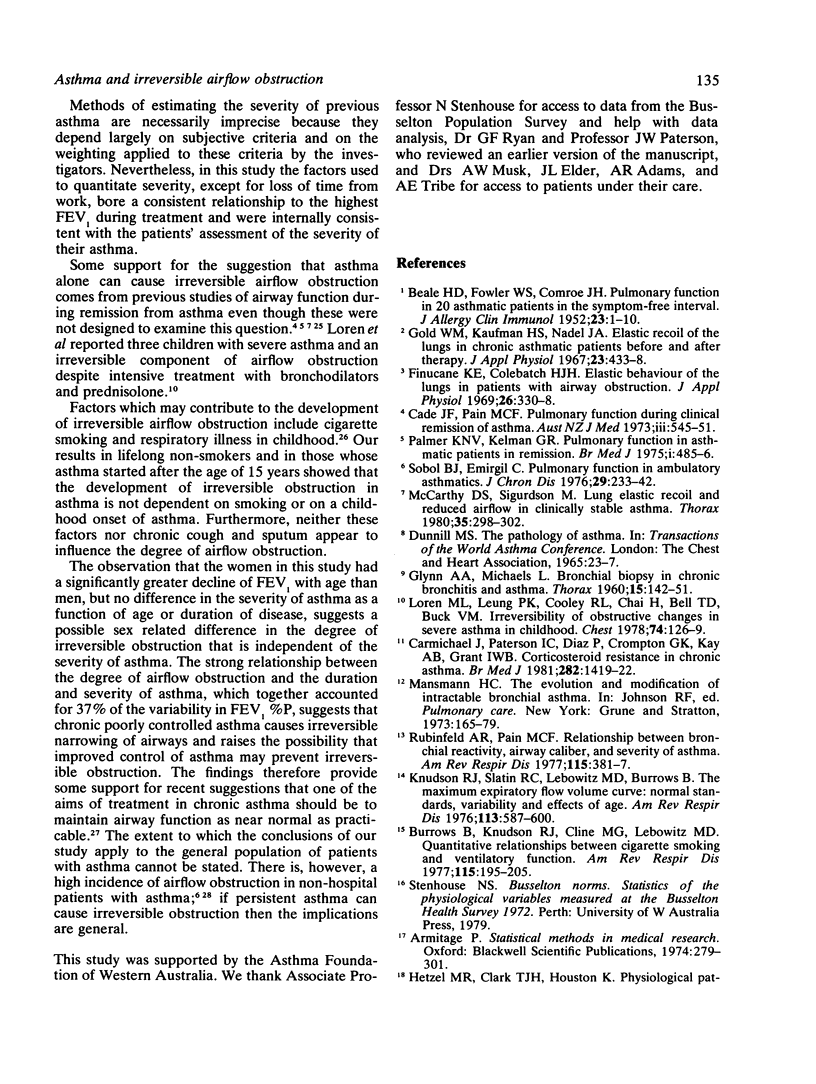
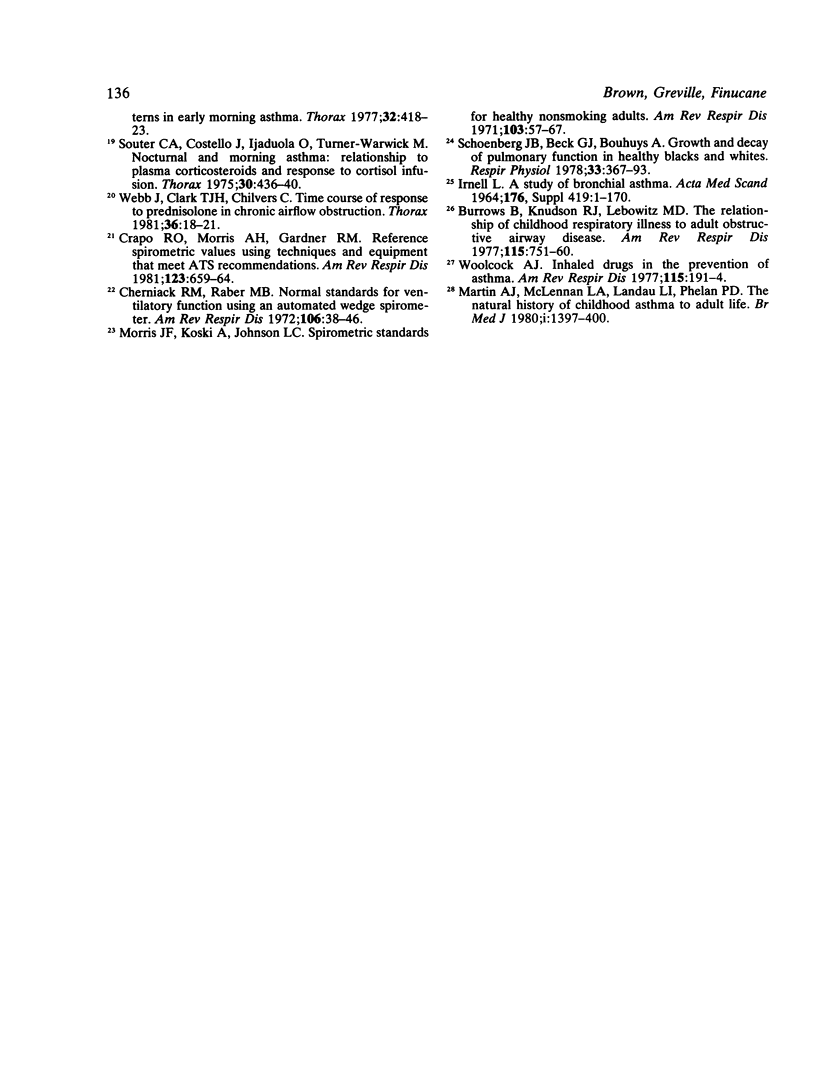
Selected References
These references are in PubMed. This may not be the complete list of references from this article.
- BEALE H. D., FOWLER W. S., COMROE J. H., Jr Pulmonary function studies in 20 asthmatic patients in the symptom-free interval. J Allergy. 1952 Jan;23(1):1–10. doi: 10.1016/0021-8707(52)90067-1. [DOI] [PubMed] [Google Scholar]
- Burrows B., Knudson R. J., Cline M. G., Lebowitz M. D. Quantitative relationships between cigarette smoking and ventilatory function. Am Rev Respir Dis. 1977 Feb;115(2):195–205. doi: 10.1164/arrd.1977.115.2.195. [DOI] [PubMed] [Google Scholar]
- Burrows B., Knudson R. J., Lebowitz M. D. The relationship of childhood respiratory illness to adult obstructive airway disease. Am Rev Respir Dis. 1977 May;115(5):751–760. doi: 10.1164/arrd.1977.115.5.751. [DOI] [PubMed] [Google Scholar]
- Cade J. F., Pain M. C. Pulmonary function during clinical remission of asthma. How reversible is asthma? Aust N Z J Med. 1973 Dec;3(6):545–551. doi: 10.1111/j.1445-5994.1973.tb04293.x. [DOI] [PubMed] [Google Scholar]
- Carmichael J., Paterson I. C., Diaz P., Crompton G. K., Kay A. B., Grant I. W. Corticosteroid resistance in chronic asthma. Br Med J (Clin Res Ed) 1981 May 2;282(6274):1419–1422. doi: 10.1136/bmj.282.6274.1419. [DOI] [PMC free article] [PubMed] [Google Scholar]
- Cherniack R. M., Raber M. B. Normal standards for ventilatory function using an automated wedge spirometer. Am Rev Respir Dis. 1972 Jul;106(1):38–46. doi: 10.1164/arrd.1972.106.1.38. [DOI] [PubMed] [Google Scholar]
- Crapo R. O., Morris A. H., Gardner R. M. Reference spirometric values using techniques and equipment that meet ATS recommendations. Am Rev Respir Dis. 1981 Jun;123(6):659–664. doi: 10.1164/arrd.1981.123.6.659. [DOI] [PubMed] [Google Scholar]
- Finucane K. E., Colebatch H. J. Elastic behavior of the lung in patients with airway obstruction. J Appl Physiol. 1969 Mar;26(3):330–338. doi: 10.1152/jappl.1969.26.3.330. [DOI] [PubMed] [Google Scholar]
- GLYNN A. A., MICHAELS L. Bronchial biopsy in chronic bronchitis and asthma. Tip Fak Mecm. 1960 Jun;23:142–153. doi: 10.1136/thx.15.2.142. [DOI] [PubMed] [Google Scholar]
- Gold W. M., Kaufman H. S., Nadel J. A. Elastic recoil of the lungs in chronic asthmatic patients before and after therapy. J Appl Physiol. 1967 Oct;23(4):433–438. doi: 10.1152/jappl.1967.23.4.433. [DOI] [PubMed] [Google Scholar]
- Hetzel M. R., Clark T. J., Houston K. Physiological patterns in early morning asthma. Thorax. 1977 Aug;32(4):418–423. doi: 10.1136/thx.32.4.418. [DOI] [PMC free article] [PubMed] [Google Scholar]
- Knudson R. J., Slatin R. C., Lebowitz M. D., Burrows B. The maximal expiratory flow-volume curve. Normal standards, variability, and effects of age. Am Rev Respir Dis. 1976 May;113(5):587–600. doi: 10.1164/arrd.1976.113.5.587. [DOI] [PubMed] [Google Scholar]
- Loren M. L., Leung P. K., Cooley R. L., Chai H., Bell T. D., Buck V. M. Irreversibility of obstructive changes in severe asthma in childhood. Chest. 1978 Aug;74(2):126–129. doi: 10.1378/chest.74.2.126. [DOI] [PubMed] [Google Scholar]
- Martin A. J., McLennan L. A., Landau L. I., Phelan P. D. The natural history of childhood asthma to adult life. Br Med J. 1980 Jun 14;280(6229):1397–1400. doi: 10.1136/bmj.280.6229.1397. [DOI] [PMC free article] [PubMed] [Google Scholar]
- McCarthy D. S., Sigurdson M. Lung elastic recoil and reduced airflow in clinically stable asthma. Thorax. 1980 Apr;35(4):298–302. doi: 10.1136/thx.35.4.298. [DOI] [PMC free article] [PubMed] [Google Scholar]
- Morris J. F., Koski A., Johnson L. C. Spirometric standards for healthy nonsmoking adults. Am Rev Respir Dis. 1971 Jan;103(1):57–67. doi: 10.1164/arrd.1971.103.1.57. [DOI] [PubMed] [Google Scholar]
- Palmer K. N., Kelman G. R. Pulmonary function in asthmatic patients in remission. Br Med J. 1975 Mar 1;1(5956):485–486. doi: 10.1136/bmj.1.5956.485. [DOI] [PMC free article] [PubMed] [Google Scholar]
- Rubinfeld A. R., Pain M. C. Relationship between bronchial reactivity, airway caliber, and severity of asthma. Am Rev Respir Dis. 1977 Mar;115(3):381–387. doi: 10.1164/arrd.1977.115.3.381. [DOI] [PubMed] [Google Scholar]
- Schoenberg J. B., Beck G. J., Bouhuys A. Growth and decay of pulmonary function in healthy blacks and whites. Respir Physiol. 1978 Jun;33(3):367–393. doi: 10.1016/0034-5687(78)90063-4. [DOI] [PubMed] [Google Scholar]
- Sobol B. J., Emirgil C. Pulmonary function in ambulatory asthmatics. J Chronic Dis. 1976 Apr;29(4):233–242. doi: 10.1016/0021-9681(76)90077-1. [DOI] [PubMed] [Google Scholar]
- Soutar C. A., Costello J., Ijaduola O., Turner-Warwick M. Nocturnal and morning asthma. Relationship to plasma corticosteroids and response to cortisol infusion. Thorax. 1975 Aug;30(4):436–440. doi: 10.1136/thx.30.4.436. [DOI] [PMC free article] [PubMed] [Google Scholar]
- Webb J., Clark T. J., Chilvers C. Time course of response to prednisolone in chronic airflow obstruction. Thorax. 1981 Jan;36(1):18–21. doi: 10.1136/thx.36.1.18. [DOI] [PMC free article] [PubMed] [Google Scholar]
- Woolcock A. J. Inhaled drugs in the prevention of asthma. Am Rev Respir Dis. 1977 Feb;115(2):191–194. doi: 10.1164/arrd.1977.115.2.191. [DOI] [PubMed] [Google Scholar]


